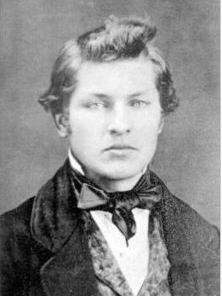After his father died in 1833, Eliza continued to run their impoverished farm to make ends meet and ensure her children’s education. However, James initially dreamed of working as a sailor, but he led mules and pulled the boats on the Ohio River’s Erie Canal. He was not a good swimmer and frequently fell overboard numerous times. James even contracted malaria in the process.
From his experience, he realized to use his brain than his brawn. James was always studious as he attended Western Reserve Eclectic Institute at Hiram, Ohio, and moved to Williams College, where he graduated in 1856. He was known to excel in academics and shown significant interest in language, mainly Greek and Latin. Eventually, he became an instructor of ancient languages and an administrator.
While studying in the Western Reserve Eclectic Institute, James Garfield courted Lucretia Rudolph, an outstanding student, and an impressive public speaker. They were married on November 11, 1858, and had seven children; however, two died in infancy.
During James Garfield’s time as a teacher, he frequently spoke at churches and was a strong advocate of free-soil principles (opposing the extension of slavery to new states). He even studied law and was ordained as a minister in the Disciples of Christ Church in Ohio before turning in to politics. In 1859, he also became a dedicated supporter of the newly organized Republican Party and was elected to the Ohio legislature.
When the American Civil War broke in 1861, he helped recruit men for battle and in the Ohio Volunteer Infantry. He commanded his troops at the Battle of Shiloh in April 1862 and the Battle of Chickamauga in September 1863 and earned the reputation of being a war hero. Although, this is also the period where he had an extramarital affair with Lucia Calhoun. He immediately admitted his infidelity to his wife and as forgiven. In one of his diary entries, he ordered to seize the letters he sent to Lucia and destroy it.
Owing to his reputation, he easily won and was elected to the United States House of Representatives without campaigning. From there, he left the battlefields and filled his seat in Congress, where he eventually became the House minority leader.
James Garfield served as the representative of Ohio’s 19th Congressional District for nine terms. He then served as the House committee chairman on Appropriations, where he mastered fiscal matters and encouraged a high protective tariff. As he was a Radical Republican, he pursued a firm policy of Reconstruction of the South. After his term in the Ohio legislature, he was elected to the United States Senate.
James Garfield was initially a dark horse candidate at the Republican presidential convention in Chicago. The delegates were divided into three camps. The conservatives led by the influential New York Senator Roscoe Cockling supported Maine Senator James G. Blaine and those who nominated Secretary of Treasury John Sherman. James Garfield steered his fellow Republicans through his extemporaneous nominating speech. Because of his prominence, he doomed Ulysses S. Grant’s candidacy.
He won the nomination and even the presidency against the Union General and Democratic Opponent Winfield S. Hancock by an extremely slim margin.
James Garfield served for a few months in the office, his core as an educator strongly supported to provide education to improve the newly freed slaves’ lives. He was also able to apply his financial expertise during his congressional service. He also worked hard for the civil service reform.
Because of his little foreign policy experience, he relied heavily on James Blaine. The believed that increasing trade with Latin America could effectively keep the European countries from dominating southern America. James Garfield also encouraged exports to boost the nation’s economy. They even hoped to negotiate peace in the Pacific War between Chile, Peru, and Bolivia. Lastly, James Garfield also considered enhancing the U.S.’s military strength overseas.
Charles J. Guiteau, a 39-year old embittered attorney, grew resentful over the numerous denials to his request for a consular post shot the president twice in the railroad station in Washington D.C. on July 2, 1881. Charles J. Guiteau immediately surrendered to the authorities and calmly announced, “I am a Stalwart. Arthur is now president of the United States.”
During that time, doctors were unaware of the dangers of unsterilized materials and even sepsis. They failed to remove the bullet on James Garfield’s body and was weakened due to infection. On September 19, 1881, he died due to blood poisoning, massive bleeding, and a cardiac arrest attributed by the unremoved bullet.
US Presidents | ||

